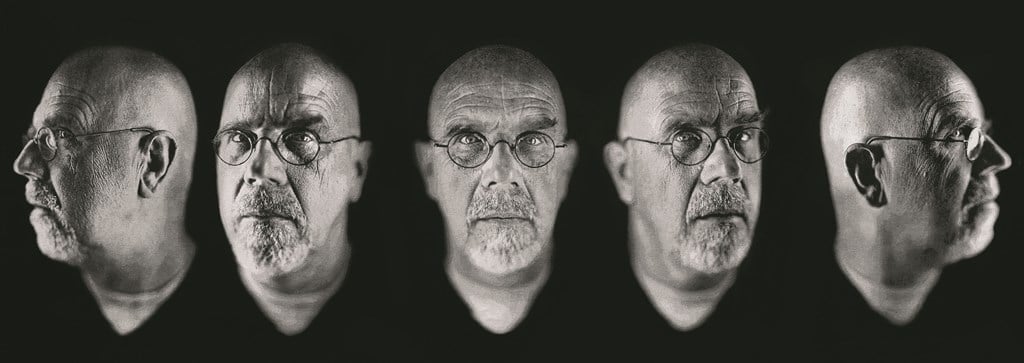
By Ronni Sandroff | Mar. 2016 | Letagemagazine.com
“Who is going to buy a nine-foot painting of someone they don’t know?” a gallery owner asked painter Chuck Close at the start of his career. “Don’t worry,” Close replied, “They’ll all go to museums.”
This story was recounted in an opening night talk by Terrie Sultan, Director of the Parrish Art Museum, Water Mill, NY, which originated the “Chuck Close Photography” exhibit that is now at the NSU Museum of Art Fort Lauderdale until Oct 2nd.
Grandiose from the start in both the scale of his work and his self-confidence, museums are indeed the perfect venue for Close’s monumental works. The show offers a generous display of Close’s large-scale nudes and portraits taken (sometimes in sections) with a large-scale Polaroid camera. Also included are some innovative daguerreotypes, a 19th-century technique which Close modernized by using banks of strobe lights. The process behind his productions are unveiled through an exhibit of contact sheets, proofs and photographs scored with ink and masking tape.
As Terrie Sultan remarked, “Close’s nudes seem strangely unsensual, yet when he occasionally turns his attention to flowers, the photographs are downright sexy.” Close’s subjects are mostly himself, friends and family, but he also turned his lens to well-known people. The shows includes portraits of Kate Moss, Alec Baldwin, Bill and Hillary Clinton as you’ve never seen them.
A nice relief from Close’s soul-baring close-ups is the Museum of Art’s downstairs exhibit: “Bellissima: Italy and High Fashion 1945-1968 (through June 5th), presented by Bvlgari. It was a great era for fashion, and I wanted all the clothes. Be sure to watch the clips from Italian films of that era, where stunning outfits are worn by women shooting handguns or traipsing through fountains in Fellini films.
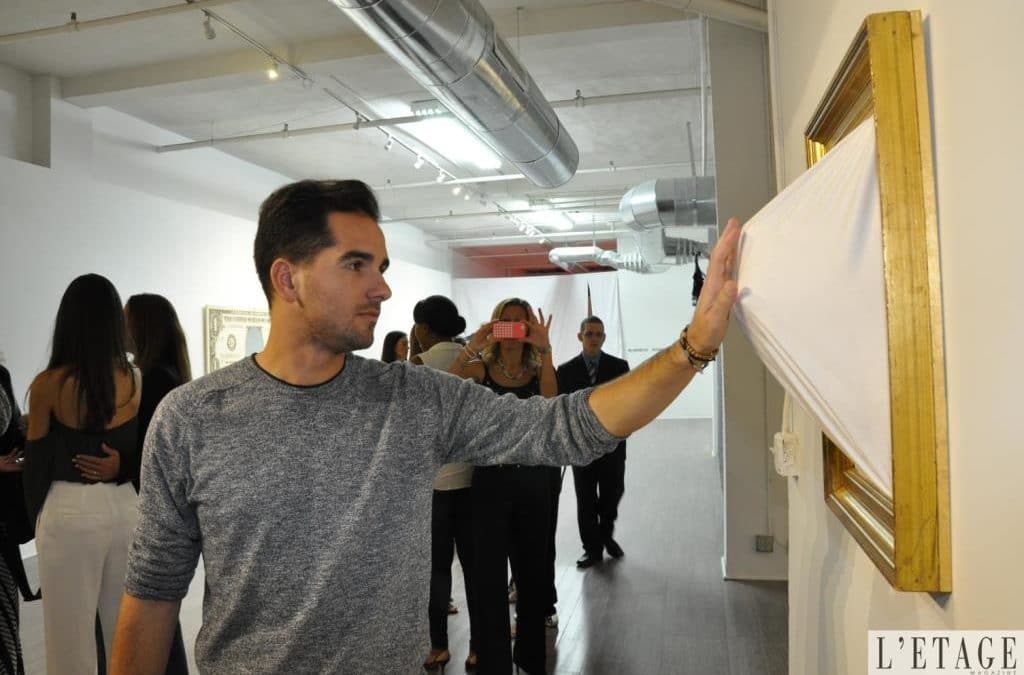
By Ronni Sandroff | Feb. 2016 | Letagemagazine.com
Alternately glitzy, stark and enigmatic, the works in Javier Martin’s new show, “War, Consumption, And Other Human Hobbies,” at Valli Art Gallery in Wynwood until October 18, are designed to shake up our vision of the world.
The young Spanish artist uses a wide range of materials, from mirrors and neon to video, wire fencing, and wood sculpture. And, he’s not shy about driving his point home. “For me the social message is always the most important,” Javier Martin told L’Etage at the opening party on September 25th. “Some people thought my collection, Close My Eyes, was superficial, perhaps because I pictured beautiful women. The neon lights blindfolding their eyes refer to the use of neon to represent brand names and urge consumption. The message is that there’s too much focus on the superficial, and we forget what’s inside.”
That commodification of beauty theme is carried on in a piece called “Empty,” an issue of Vogue magazine in which the cover model’s shape has been hollowed out of each page. And a more direct comment on fashion is Martin’s series of guns and rifles made out of original Louis Vuitton fabric handbags.
In some of Martin’s work, the message seems a bit bald. “Great Opportunity at Wynwood 2015,” is a small plot of wood and soil. And the giant dollar bill with a mirror instead of George Washington’s face seems like a fun house piece.
Much more powerful are the photos of Martin’s performance in the streets of Spain, in which he is sitting on a sidewalk begging, body and head tightly covered in white jogging suit and a large mirror where his face should be. The mirror looks up to reflect the faces of those who bend over to give him alms. “It was fascinating to watch people look at themselves through this mirror,” Martin said.
At Valli, a large installation cordons off part of the room with a tall wire fence with two pieces of clothing – one stained with a little blood – hanging on top. It seems to represent oppression of many kinds and is unexpectedly moving.
More enigmatic is the gold brick that’s also a scrub brush, the piece the gallery chose (with an arm added) to promote the exhibit. There are many more surprises in this absorbing show.
For more information, please visit the websites:: http://www.valliartllc.com/ & http://www.javiermartinart.com/
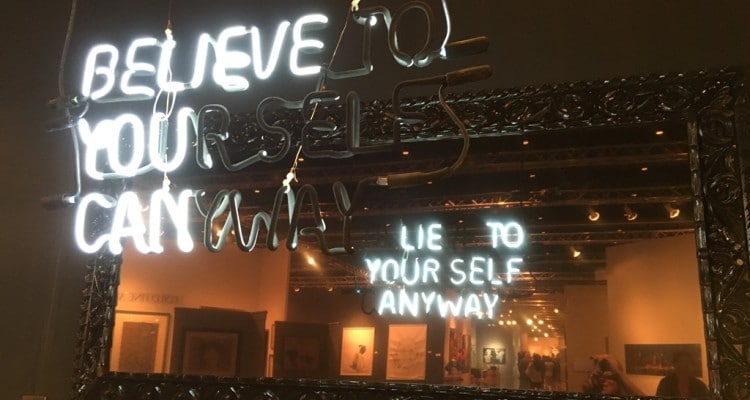
By Ronni Sandroff | Jan. 2016 | Letagemagazine.com
Many exhibitors at ArtPalmBeach seemed to have your living room in mind. Unlike the haute wares at ArtBaselMiami, the 85 international galleries at ArtPalmBeach displayed an array of less expensive work by both emerging and well-known artists. For example, limited edition signed, framed lithographs by famous artists, such as Leger, Lichtenstein, Miro, and Stella, cost less than $15,000 and would look dazzling over your couch.
Perhaps, the biggest crowd-pleasers were Colombian artist Camille Matiz’ double-think neon installations which offered a counter message when viewed through their ornate mirrors. One paired the messages “Take a selfie” and “Fake a Life.” And, my favorite read “Believe you can,” which morphed to “Lie to yourself anyway,” when viewed through the mirror.
The annual Palm Beach exhibit attracted a number of galleries which also displayed during ArtBaselMiami. Unfortunately, I missed the Hecho en Cuba (Made in Cuba) exhibit by Arte Collective during ArtBasel, but curator Yubal Marquez Fleites brought some riveting pieces from that show to Palm Beach. I was particularly impressed by Edel Morales’ inked “Pájaro pez, mujer, árbaol: la noche, marzo-abril, variaciones” and Abel Masot’s “Voces de Abandono,” in acrylic. Both these young artists live in Havana, and their works have a Renaissance-like visual depth and soulfulness. Also powerful and unsettling, was German artist Hans Aichinger’s Das Zeichen (the sign), in oil.
There was ample selection of art masquerading as home furnishings (or vice versa) throughout the fair. I was very absorbed by a simple but stunning tabletop collection of oil painted glass objects, argristocracy 2007-2010, by Pittsburgh-Based Matthew Eskuche. And couldn’t stop smiling at the paint-spilling artist’s table by Colombian artist Jorge Magyaroff. I also have just the spot for Bostonian Toots Zynsky’s very sensuous Red Vase, $27,000.
Yeah, I can’t afford any of this either, but its fun to look, and fantasize. If you missed the Jan 21-24 Palm Beach exhibit, consider a jaunt to the curated Art Boca Raton Contemporary Art Fair, March 17-21, at the International Pavilion of the Palm Beaches in cooperation with Florida Atlantic University.
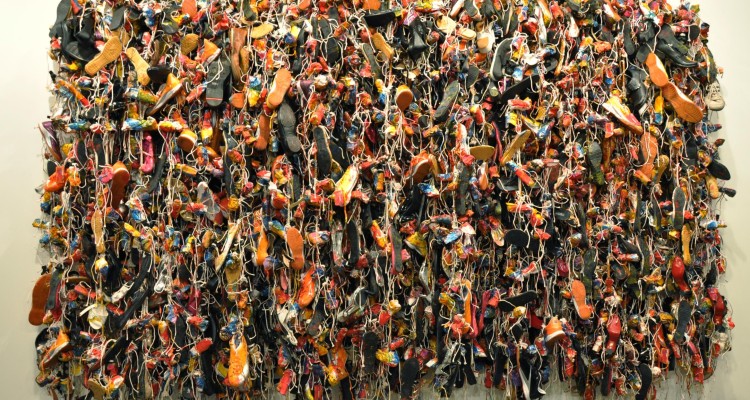
By Ronni Sandroff | Dec. 2015 | Letagemagazine.com
Although the use of everyday objects in works of art was so persistent at Art Basel Miami that it bordered on cliche, there was an exciting number of sensibility-shifting works of art built from very humble materials.
A piece which drew me back several times was an epic collage/painting of shoes and sneakers by Hassan Sharif (b. 1951) from Dubai, U.A.E., shown by Alexander Gray Associates, New York. Sharif’s large 2014 piece, called “Ladies and Gentleman,” weaves together multitudes of shoes in a way that they become cultural artifacts, with themes of diaspora and immigration, as well as a blending of genders, running through the piece. At moments, I thought of the displays of shoes taken from concentration camp victims on view at Holocaust museums. Yet Sharif also captures the colorful verve of the shoes themselves, which always seem in motion even when jelled together. Both “Ladies and Gentleman” and Sharif’s Spoons No. 5 2014 jangle the viewer’s perception of the stability of everyday objects, as they escape their designated roles and become signifiers of consumption and how we treat each other.
How an everyday thing (and the aspiration it symbolizes) disappeared was the theme of Fritzia Irizar’s on-site dramatization presented by Arredondo\Arozarena. The piece, Untitled (The disappearance of the symbol), shows the unraveling of a Phrygian cap. In ancient Phrygia (now Turkey) a Phrygian cap was donned by slaves who were liberated. The cap became a symbol of freedom during the French Revolution and was embossed on Mexican coins as that nation moved toward a republic. The symbol then disappeared. For the Art Basel exhibit, Irizar wove such a cap out of gold thread and created a series of pulleys that slowly unwove the cap until it completely disappeared by the end of the exhibition.
You’d think that pennies and coffee beans wouldn’t engage the eye, but witness Danish artist Nina Beier’s pieces presented by Standard (Oslo). The trail of coffee bean circles, each topped by a tiny cup, seemed to me to represent — and dignify — morning after morning after morning. And mounds of glistening, almost smiling, pennies, each topped by a water faucet, had a bit to say about the attraction and absurdity of wealth.
I’m not at all sure what California artist B. Wurtz has to say, but he can make compelling art out of the most ordinary of objects. Metro Pictures showed his Untitled (pan paintings), a series of metal catering type-pans painted on the backs in vivid auto-like colors. He also showed a deceptively simple piece of three stacked colanders that held my attention amid all the clamor of Art Basel and put a grin on my face. In a show that featured works that used elaborately expensive materials, Wurtz’ work demonstrates that imaginative recycling can produce a huge impact.
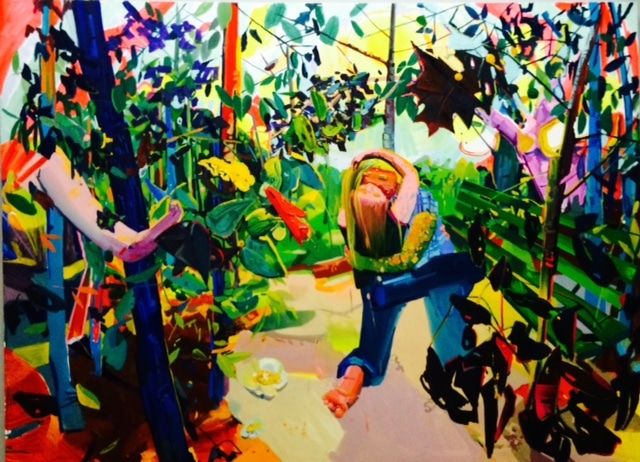
By Ronni Sandroff | Dec. 2015 | Letagemagazine.com
One of the more encouraging things about the rotating exhibit of over 100 contemporary female artists from 28 countries at the Rubell Family Collection is that today’s female artists don’t have to wait as long as, say, Rosalyn Drexler, to get some recognition. A Jennifer Rubell performance piece called “Devotion” opened the NO MAN’S LAND, involving an engaged couple handing out hunks of bread and butter to a crushing crowd. The piece, which explores repetition as devotion, seemed more heart-felt than Rubell’s “Lysa III, 2014,” a life-size female mannequin engineered to crack walnuts in her crotch (yes, you could participate). Although funny, that piece seems not only to comment on — but also to indulge in — female body exploitation and disrespect.
The extensive exhibit at the Rubell will reward quiet contemplation once the crowds have diminished. Among my favorites were Sonia Gomes’ remarkably alive and sinuous rope sculptures. She is known to work with textiles she finds or receives as gifts, according to her gallery, Brazil’s Mendes Wood DM. The memory of the material itself is synthesized with the racial and emotional issues encrusted in the identity of the Brazilian with indigenous and African cultural influences.
I was enchanted by the life-size sculptures of girls with neon rings, such as Apocalypse Ballet (Pink Ring), 2006 by Mai-Thu Perret from Geneva, Switzerland. Perret’s sculptures emerge out of her written fictional work in progress that describes the lives of a group of women who form a commune called New Ponderosa Yar Zero in the New Mexican desert, according to artspace.com.
More conceptional and little harder to get is “Eureka, 1993” a footed bathtub full of lard indented with a body-cast of the artist, Janine Antoni, who was born in Freeport, Bahamas, lives in New York. It helps to know that Antoni often uses her body as an entity in her performance art, sculpture, and photography and considers lard a stand-in for the female body.
Although the mother-and-child theme was surprisingly scarce among the female artists exhibited in NO MAN’S LAND, German artist Paloma Varga Weisz “Waldfrau, getarnt, 2002” has a startling, engrossing version in limewood, larch tree, and camouflage fabric.
Two richly-beautiful stylized works by Hayv Kahraman, born in Baghdad, Iraq, and living in California have disturbing subject matter. “Migrant 1. 2009” shows two women, each in a noose. Another, “Persian Couple I, 2009” shows a woman exposing herself to a lover with a distant and pained expression on her averted face. Kahraman had a show at Jack Shianman, New York, in 2015 called “How Iraqi are you?”
A painting with delicate realism that that seems to capture the essence of young love at a house party with the right music on is “Efulefu: The Lost One, 2011,” By Njideka Akunyili Crosby, born in Nigeria, living in Los Angeles.
And for a different take, consider the exuberant embrace of lovers (if you can spot them) in “Young Love” by Dana Schutz, born in Michigan, lives in Brooklyn. Bold swipes of the paintbrush creating a riotously colored world in motion.
If you can find any womanly commonality among these artists, do let me know. I’ve only found that each work beckons and reveals itself in very different ways.
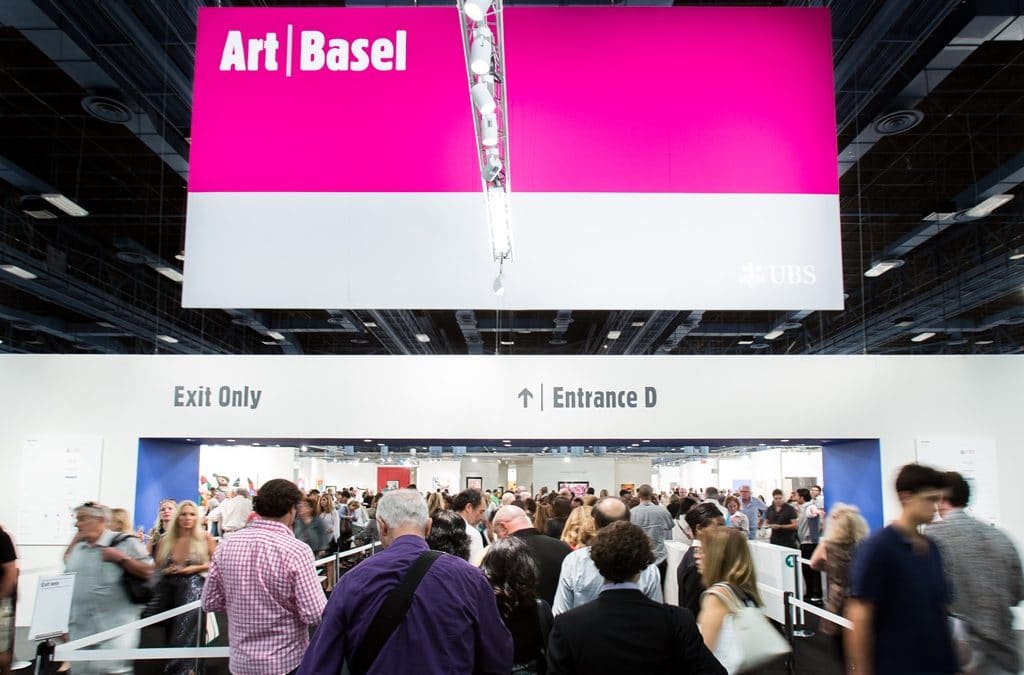
By Ronni Sandroff | Oct. 2015 | Letagemagazine.com
We can’t be the only ones who find five days too short to absorb over 500,000 square feet of exhibits by hundreds art galleries, 17 plus side fairs, and at least 7 special museum exhibits (not to mention all those parties). So L’Etage is asking Art Basel veterans to please send us your tricks, tips and peak experiences from previous years so we can assemble advice about navigating the overwhelming sea of riches. WRITE US AT: Info@letagemag.com
Art Basel has released the list of 267 art galleries from 32 countries who will exhibit at the Miami Beach Convention Center from December 3 – December 6, 2015. The show added 29 new galleries this year. Only about half of the participating galleries have exhibition spaces in the U.S., so this show brings much seldom-seen art to our soil. We’ll bring you the schedule of cultural events, panels and talks that accompany Art Basel as soon as they’re released. And look for L’Etage’s upcoming list and comments on the other Miami and Miami Beach art shows and fairs scheduled to coincide with Art Basel.
Art Basel sectors organize the convention center
Each sector of Art Basel has its own committee of experts and selection process for participants.
Galleries, the main sector, features 191 galleries presenting painting, sculpture, drawing, installation, photography, video and editioned works.
Editions presents 12 global leaders in the field of prints and limited-editioned works.
Survey, which debuted last year, returns with 14 art historical projects.
Positions focuses on emerging artists, with 16 curated solo booths. Interestingly, it features an installation by Dan Bayles at François Ghebaly Gallery which will evolve during the show in response to other works on display.
Nova provides a platform for younger galleries to present new work by up to three artists and will feature 34 exhibitors.
Project based sectors, Kabinett, Public, and Film, will release their exhibitors over the coming months.
Related shows proliferate
South Florida’s leading museums time their strongest exhibitions of the year to coincide with Art Basel.
Bass Museum of Art, undergoing renovation, presents a series of programs at the Miami Beach Library, directly across from the museum. A new performance by Sylvie Fleury is presented in December.
Design Miami/ featuring galleries specializing in twentieth and twenty-first century design will take place from December 2 to December 6, 2015, at Meridian & 19th Street, opposite the Miami Beach Convention Center.
The Institute of Contemporary Art, Miami (ICA Miami) will present ‘Shannon Ebner – A Public Character’ and ‘Alex Bag – The Van (Redux).
Museum of Contemporary Art (MOCA) ‘Carlos Salas: Latin America and the Global Imagination’ and Hortense Valpinçon
NSU Art Museum Fort Lauderdale will show ‘Pablo Picasso: Painted Ceramics and Works on Paper, 1931-71’, ‘War Horses: Helhesten and Danish Avant-Garde during World War II,’ ‘The Indestructible Lee Miller’, and ‘Revolution of the Eye: Modern Art and the Birth of American Television.’
Norton Museum of Art, ‘The Summer of ’68: Photographing the Black Panthers’, ‘Vincent van Gogh’s The Poplars at Saint-Rémy,’ ‘Edgar Degas’ Portrait of Mlle.
Pérez Art Museum Miami (PAMM) in December will present ‘Nari Ward: Sun Splashed,’ ‘No Boundaries: Aboriginal Australian Contemporary Abstract Painting.’
Wolfsonian-FIU, ‘Margin of Error’ and ‘Philodendron: From Pan-Latin Exotic to American Modern’
Private collections: Visitors from across the world will also have the opportunity to view the city’s internationally renowned private collections. This includes much-anticipated exhibitions at the Cisneros Fontanals Art Foundation (CIFO), the de la Cruz Collection Contemporary Art Space, the Margulies Collection at the Warehouse and the Rubell Family Collection.






